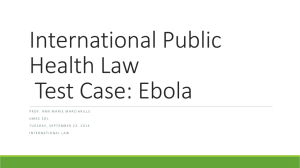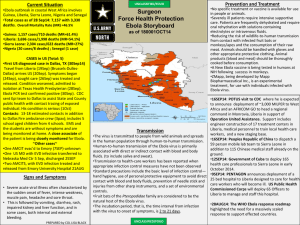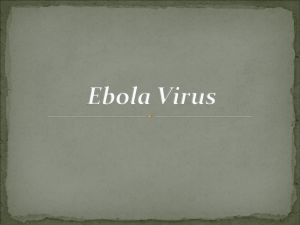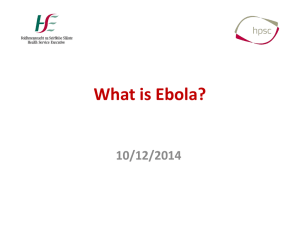Ebola Virus Disease (Poster)
advertisement
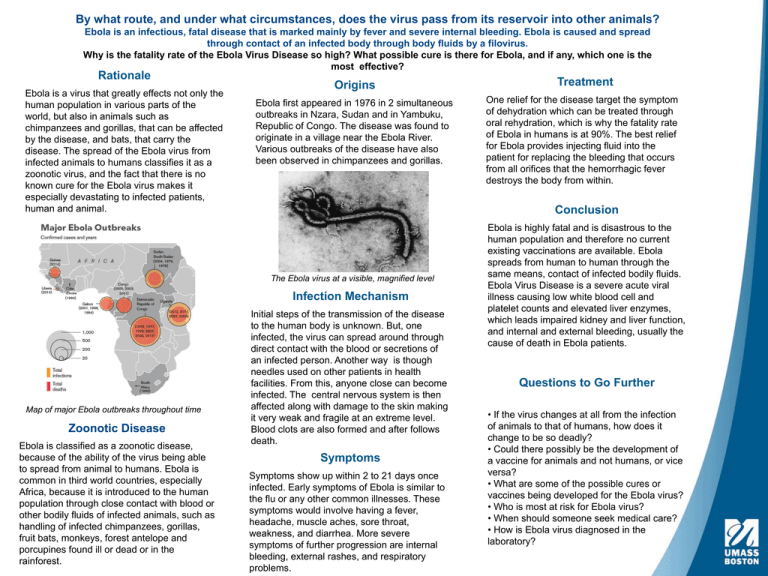
By what route, and under what circumstances, does the virus pass from its reservoir into other animals? Ebola is an infectious, fatal disease that is marked mainly by fever and severe internal bleeding. Ebola is caused and spread through contact of an infected body through body fluids by a filovirus. Why is the fatality rate of the Ebola Virus Disease so high? What possible cure is there for Ebola, and if any, which one is the most effective? Rationale Ebola is a virus that greatly effects not only the human population in various parts of the world, but also in animals such as chimpanzees and gorillas, that can be affected by the disease, and bats, that carry the disease. The spread of the Ebola virus from infected animals to humans classifies it as a zoonotic virus, and the fact that there is no known cure for the Ebola virus makes it especially devastating to infected patients, human and animal. Origins Ebola first appeared in 1976 in 2 simultaneous outbreaks in Nzara, Sudan and in Yambuku, Republic of Congo. The disease was found to originate in a village near the Ebola River. Various outbreaks of the disease have also been observed in chimpanzees and gorillas. Infection Mechanism Zoonotic Disease Ebola is classified as a zoonotic disease, because of the ability of the virus being able to spread from animal to humans. Ebola is common in third world countries, especially Africa, because it is introduced to the human population through close contact with blood or other bodily fluids of infected animals, such as handling of infected chimpanzees, gorillas, fruit bats, monkeys, forest antelope and porcupines found ill or dead or in the rainforest. One relief for the disease target the symptom of dehydration which can be treated through oral rehydration, which is why the fatality rate of Ebola in humans is at 90%. The best relief for Ebola provides injecting fluid into the patient for replacing the bleeding that occurs from all orifices that the hemorrhagic fever destroys the body from within. Conclusion The Ebola virus at a visible, magnified level Map of major Ebola outbreaks throughout time Treatment Initial steps of the transmission of the disease to the human body is unknown. But, one infected, the virus can spread around through direct contact with the blood or secretions of an infected person. Another way is though needles used on other patients in health facilities. From this, anyone close can become infected. The central nervous system is then affected along with damage to the skin making it very weak and fragile at an extreme level. Blood clots are also formed and after follows death. Symptoms Symptoms show up within 2 to 21 days once infected. Early symptoms of Ebola is similar to the flu or any other common illnesses. These symptoms would involve having a fever, headache, muscle aches, sore throat, weakness, and diarrhea. More severe symptoms of further progression are internal bleeding, external rashes, and respiratory problems. Ebola is highly fatal and is disastrous to the human population and therefore no current existing vaccinations are available. Ebola spreads from human to human through the same means, contact of infected bodily fluids. Ebola Virus Disease is a severe acute viral illness causing low white blood cell and platelet counts and elevated liver enzymes, which leads impaired kidney and liver function, and internal and external bleeding, usually the cause of death in Ebola patients. Questions to Go Further • If the virus changes at all from the infection of animals to that of humans, how does it change to be so deadly? • Could there possibly be the development of a vaccine for animals and not humans, or vice versa? • What are some of the possible cures or vaccines being developed for the Ebola virus? • Who is most at risk for Ebola virus? • When should someone seek medical care? • How is Ebola virus diagnosed in the laboratory?



